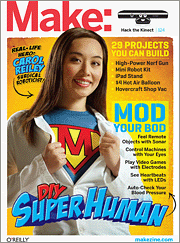
Recently, while looking online for woodworking tools appropriately sized for my preschool daughter, I came across some construction sets geared toward children. Thinking fondly of the sets I had when I was little, I looked closely to see if I could find one suited for my kids.
I was intrigued by one kit that promised “real” construction play. While the kits that I played with in elementary school typically included glue, nails, and a rough picture of something I could build with a hammer and maybe a saw, this kit included foam “wood,” plastic tools, and plastic nails. The promotional materials stressed that these are “real materials” and “real tools.” Real: yes. Realistic: no.
The really surprising thing was that this toy is labeled for children ages 6+ and, on Amazon, has a manufacturer’s recommended age range of 6–15. Minutes earlier I’d been confidently pricing hand drills and hammers. Now this toy seemed to be telling me I should wait on those tools until my daughter reaches middle school. So how old is old enough to hand kids real tools?
Making objects is similar to making music. We would think it outrageous to wait until a student reaches university to give them their first non-toy musical instrument. However, many students reach their first year of college without much experience with tools. I recently spoke to an engineering professor who mentioned that when he asked a class of 35 first-year engineering students how many had used a drill press before, not a single hand went up. How many had taken apart one of their toys when they were younger? Again, not a single student raised a hand. And that’s in a roomful of future engineers.
The more I research children and tool use, the more I notice how things have changed. Kids were once trusted with real, metal tools.In the early 20th century, it was common for elementary schools to teach manual training. In 1900, Frank Ball, a teacher at the University Elementary School in Chicago, wrote, “At the present time no thoroughly equipped school is complete without its department of manual training or construction work.” A book written in 1964 by John Feirer and John Lindbeck, of the Industrial Education Department at Western Michigan University, talks about outfitting elementary school shops and advises that the tools should be maintained well, since “the sharp, well-cared-for tool is safe, easy and fun to use.” Very rarely these days do we hear “fun,” “sharp,” and “elementary school” in the same conversation.
As a parent and a teacher, I understand the fear of injuries, and suspect it’s one of the reasons behind the decline in kids gaining hands-on skills. When it comes to tools, our risk aversion is causing more harm than good. The promotional video for the abovementioned “real” construction set showed how safe the tools are by having a child saw his hand with no injury. My 16-month-old daughter has plastic tools for now, but I’ll definitely correct her if I see her sawing her arm. We don’t do that with real tools, so I wouldn’t want her to do it with her plastic tools.
Combine an eager child, real tools and materials, appropriate training, and supervision, and you’ll be surprised by the results. More importantly, you’ll see a young maker who is gaining a useful skill and confidence in her ability to bring ideas to life.
AnnMarie Thomas teaches in the engineering and engineering education programs at the University of St. Thomas in St. Paul, Minn. She’s also the mother of two young makers.
This column first appeared in MAKE Volume 29, on page 27.
From the pages of MAKE Volume 29:
We have the technology (to quote The Six Million Dollar Man), but commercial tools for exploring, assisting, and augmenting our bodies really can approach a price tag of $6 million. Medical and assistive tech manufacturers must pay not just for R&D, but for expensive clinical trials, regulatory compliance, and liability — and doesn’t help with low pricing that these devices are typically paid for through insurance, rather than purchased directly. But many gadgets that restore people’s abilities or enable new “superpowers” are surprisingly easy to make, and for tiny fractions of the costs of off-the-shelf equivalents. MAKE Volume 29, the “DIY Superhuman” issue, explains how.
ADVERTISEMENT







